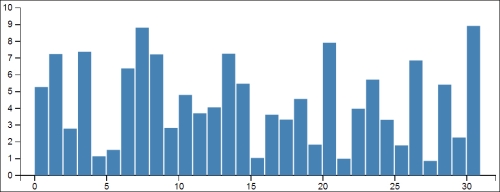A bar chart is a visualization that uses either horizontal (row charts) or vertical (column charts) rectangular bars with length proportional to the values that they represent. In this recipe we will implement a column chart using D3. A column chart is capable of visually representing two variables at the same time with its y axis; in other words, the bar height, and its x axis. The x axis values can be either discrete or continuous (for example, a histogram). In our example we choose to visualize continuous values on the x axis and hence effectively implementing a histogram. However, the same techniques can be applied when working with discrete values.
Open your local copy of the following file in your web browser:
https://github.com/NickQiZhu/d3-cookbook/blob/master/src/chapter8/bar-chart.html
The following code example shows the important implementation aspects of a histogram with accessors and peripheral graphic implementation details omitted.
...
var _width = 600, _height = 250,
_margins = {top: 30, left: 30, right: 30, bottom: 30},
_x, _y,
_data = [],
_colors = d3.scale.category10(),
_svg,
_bodyG;
_chart.render = function () {
if (!_svg) {
_svg = d3.select("body").append("svg")
.attr("height", _height)
.attr("width", _width);
renderAxes(_svg);
defineBodyClip(_svg);
}
renderBody(_svg);
};
...
function renderBody(svg) {
if (!_bodyG)
_bodyG = svg.append("g")
.attr("class", "body")
.attr("transform", "translate("
+ xStart()
+ ","
+ yEnd() + ")")
.attr("clip-path", "url(#body-clip)");
renderBars();
}
function renderBars() {
var padding = 2; // <-A
_bodyG.selectAll("rect.bar")
.data(_data)
.enter()
.append("rect") // <-B
.attr("class", "bar");
_bodyG.selectAll("rect.bar")
.data(_data)
.transition()
.attr("x", function (d) {
return _x(d.x); // <-C
})
.attr("y", function (d) {
return _y(d.y); // <-D
})
.attr("height", function (d) {
return yStart() - _y(d.y); // <-E
})
.attr("width", function(d){
return Math.floor(quadrantWidth() / _data.length) - padding;
});
}
...This recipe generates the following visualization:

Bar chart (histogram)
One major difference here is that the bar chart implementation does not support multiple data series. Therefore instead of using a 2-dimensional array storing multiple data series as we did with other charts so far, in this implementation, the _data array simply stores a single set of data points directly. Main bar chart related visualization logic resides in the renderBars function.
function renderBars() {
var padding = 2; // <-A
...
}In the first step, we defined the padding between bars (line A), so later on we can automatically calculate the width of each bar. Afterwards we generate an svg:rect element (the bars) for each data point (line B).
_bodyG.selectAll("rect.bar")
.data(_data)
.enter()
.append("rect") // <-B
.attr("class", "bar");Then in the update section we place each bar at the correct coordinates using its x and y attributes (line C and D) and extend each bar all the way down to touch the x axis with an adaptive height calculated on line E.
_bodyG.selectAll("rect.bar")
.data(_data)
.transition()
.attr("x", function (d) {
return _x(d.x); // <-C
})
.attr("y", function (d) {
return _y(d.y); // <-D
})
.attr("height", function (d) {
return yStart() - _y(d.y); // <-E
})Finally we calculate the optimal width for each bar using the number of bars as well as the padding value we have defined earlier.
.attr("width", function(d){
return Math.floor(quadrantWidth() / _data.length) - padding;
});Of course in a more flexible implementation, we can make the padding configurable instead of being fixed to 2 pixels.
Before planning to implement your own reusable chart for your next visualization project, make sure you also check out the following open source reusable chart projects based on D3:
- NVD3: http://nvd3.org/.
- Rickshaw: http://code.shutterstock.com/rickshaw/.
